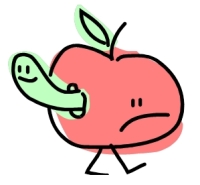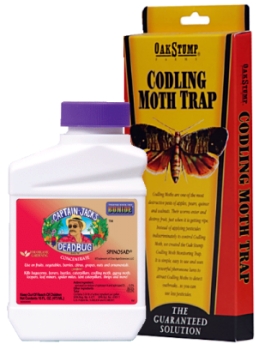How to Help Keep Worms out of Your Apples

Why Do I get Worms in my Apples or Pears?
First of all, it's important to understand how and when the worms get into your apples and/or pears. During the summer and early fall, customers often bring us apples with the remnants of worm damage or with a worm still in the apple and want to know how to get rid of these worms. Unfortunately, at that point the damage is already done, and there is little to protect your current apple or pear crop from the worms. The only way to salvage the fruit at that point is to cut out the bad portions of apple or pear.
The damage starts in the Spring when a moth known as the codling moth is busy laying its eggs at the base of your newly formed apples or pears and also on the leaves. These worms/caterpillars then hatch and work their way into the center of the newly formed apple often without detection, where they remain until they mature. Once they have matured, they work their way out of the apple or pear in mid to late summer. They then make their way down the tree and into the soil to cocoon and wait to begin the cycle again next Spring.

Question: So How Do I Stop the Worm From Getting into my Fruit?
The key to stopping the worm from
getting into your apples or pears is by eliminating the moth. Determing the
exact time that the moth is active in your garden can be difficult since
weather plays a big role on when the moth is laying its eggs. Generally, they
are active from about the time your tree flowers to about the first part of
June. We recommend the following strategy to help reduce and hopefully
eliminate the worms in your apples. One thing to remember is that if you have
had severe infestations of worms in the past, it may take a couple of years to
get acceptable control.
1. Spray Apple/Pear Trees in early Spring.
One of the first things you can do in the early Spring before the apple tree
begins to bloom is to spray your fruit trees with a pyrethrin based spray like Bonide Orchard Spray or Monterey Take Down. The reason for spraying is to kill the codling moths as they
begin to emerge from their cocoons in the Spring. Usually this spraying would
occur approximately about two weeks before the trees begin to flower.
2. Hang Codling Moth Traps. Another way to reduce the codling moth
population and also to detect moth activity is to hang Codling Moth Traps in
your apple or pear trees. These traps contain a pheromone lure that attracts
the male codling moth. Without the male moth, the female moth won't be able to
produce eggs. The traps should be hung toward the outside of the tree ensuring
a clear path for the moths to be able to easily enter the traps. The pheromone
lures are effective for about three weeks, so you may need to hang a second set
of traps a few weeks after the first traps were hung. The first traps can be
hung just before bud break (right before the tree begins to flower). By
monitoring the traps, you will be able to know if the moths are active in your
yard. When you see moths being caught in the traps, you can begin step
3.
3. Spray your Fruit Tree.
After your apple or pear tree has finished flowering and the fruit is beginning
to set, you can spray the tree with a product containing Spinosad. You
can repeat this spraying about every two weeks for about 3 to 4 applications. (If
you have only had small incidents of worms in your apples, one application may
be enough). Generally, this spraying would begin in late March or Early April
and end in late May. Monitoring the codling moth traps will also help you know
when you need to spray.
4. Follow-up Spray. In the late summer,
it might be a good idea to do a follow-up spray around the tree with a pyrethrin based spray to get any of the worms that may have been missed
and stop them from starting another generation of codling
moths.
Remember that this is a recommended strategy for getting control
of the worms that appear in your apples and pears.
Final thought:
"The only thing worse than finding a worm in your apple is finding half a
worm."